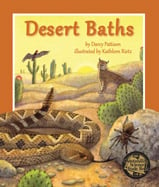Alignment to Standards for WV

| Grade | Number | Standard |
|---|---|---|
| 1 | SC.O.1.1.03 | changes in the environment: life cycles, motion of celestial objects, or sun and shadow |
| 1 | SC.O.1.2.05 | depict movement of living things in air, water and on land. (e.g., birds flying, fish swimming, or worms burrowing in soil). |
| 1 | SC.O.1.2.16 | observe and discuss the importance of objects in the day and night sky. |
| 2 | SC.O.2.2.05 | compare and contrast simple models of different kinds of habitats, including a forest and a stream. |
| 2 | SS.O.02.04.03 | recognize major geographic features on a variety of maps and globes (e.g., rivers, lakes, oceans, islands, continents, mountains). |
| 3 | SC.O.3.2.03 | compare physical characteristics and behaviors of living organisms and explain how they are adapted to a specific environment (e.g., beaks and feet in birds, seed dispersal, camouflage, or different types of flowers). |
| 3 | SC.O.3.2.18 | recognize the relative movement of the Earth and moon in relation to the sun. |
| 3 | SC.O.3.2.22 | identify geographical features using a model or map. |
| 3 | SS.O.03.04.02 | locate north, south, east, west, borders, lines of longitude and latitude, equator, north and south poles and time zones using a map. |
| 3 | SS.O.03.04.03 | recognize world geographic features (e.g., peninsulas, islands, continents, straits, mountains, rivers, deserts, oceans, seas, harbors, gulfs, forests, oases). |
| 3,4 | SC.S.3&4.3c | observe and identify patterns of change, consistency or regularity within the environment. |
| 4 | SC.0.4.2.01 | describe the different characteristics of plants and animals, which help them to survive in different niches and environments. |
| 4 | SS.O.04.04.01 | locate North, South and Central American countries and describe their major physical features (e.g., bodies of water, mountains, rivers, grasslands, oases) using geographic terms. |
| 4 | SS.S.G.04a | interpret and choose maps, globes and other geographic tools to categorize and organize information about personal directions, people, places, and environments (The World in Spatial Terms). |
| 5 | SC.O.5.2.06 | compare and contrast how the different characteristics of plants and animals help them to survive in different niches and environments including adaptations, natural selection, and extinction. |
| 5 | SC.O.5.2.19 | identify and describe natural landforms and explain how they change and impact weather and climate. |
| K | SC.O.K.2.02 | observe and describe the movement, growth and changes in plants and animals. |
| K | SC.O.K.2.11 | identify objects in the day and night sky (e.g., moon, stars, or sun). |
| K | SC.O.K.3.02 | observe and point out that change occurs gradually, repetitively, or randomly within the environment. |
| K | SS.O.K.04.01 | locate bodies of water and land masses using a globe or a map. |
| K-5 | SS.S.01-5.04a | interpret, and choose maps, globes and other geographic tools to categorize and organize information about personal directions, people, places and environments (The World in Spatial Terms). |
| K-5 | SS.S.WV.04a | interpret and choose maps, globes, and other geographic tools to categorize and organize information about personal directions, people, places, and environments (The World in Spatial Terms). |
| K-5 | SS.S.WV.04f | point out geographic perspective and the tools and assess techniques available for geographic study (Uses of Geography). |